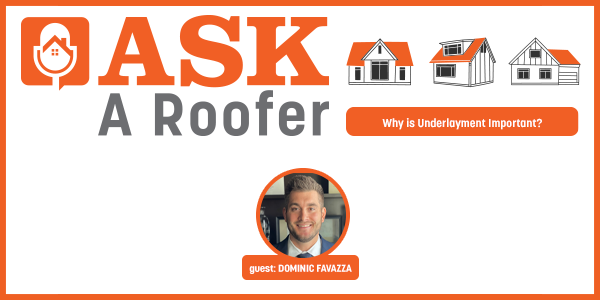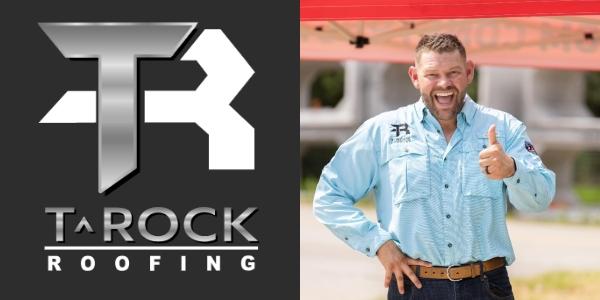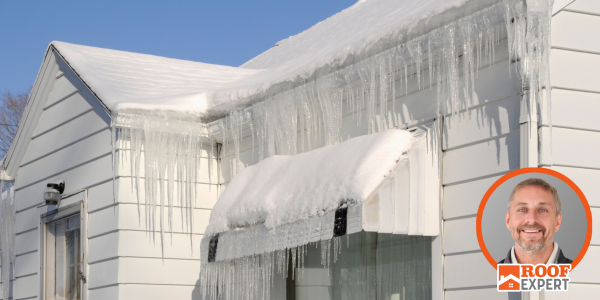Why is Underlayment Important for your Roof? - PODCAST TRANSCRIPTION

Editor's note: The following is the transcript of an live interview with Dominic Favazza of GCP. You can read the interview below or listen to the podcast.
Alice Reynolds:
Welcome to the AskARoofer Podcast, a podcast for people with roofs. My name is Alice Reynolds. I'm a new homeowner.
Megan ellsworth:
And my name is Megan Ellsworth, a roofing enthusiast. And we are with RoofersCoffeeShop.
Alice Reynolds:
We want to share the knowledge of the contractors we work with every day with home and building owners.
Megan ellsworth:
So please join us as we talk with industry experts, roofing contractors, business owners, and more to answer all of your burning questions about the health and maintenance of your roof.
Megan ellsworth:
Hello, welcome back to the AskARoofer podcast. My name is Megan Ellsworth and I have my co-host here, Alice Reynolds.
Alice Reynolds:
Hello everyone.
Megan ellsworth:
We are very excited to be talking about all things under layman today with GCP. We have Dominic here. So hi Dominic.
Dominic Favazza:
Hi, how you doing? Thanks so much for having me.
Megan ellsworth:
Yeah, we're so glad to have you here chatting with us. Why don't you go ahead and just introduce yourself. Tell us a little bit about you and GCP
Dominic Favazza:
Sure. Absolutely. So I'm Dominic Favazza. I have been with GCP for a little over two years now. I am the regional sales manager for the Mid-Atlantic for GCP on the residential side. Now, as far as myself, I've been in the industry, both from the residential side and the commercial side, for over 12 years. I started with a roofing company, a contractor. I've done everything from estimating to a quality assurance to project management, everything. So I've seen all sides of the business on both a commercial and residential end over the past 12 years. And now that I'm with GCP... Again, GCP, we are a spinoff of W.R. Grace in 2016, and we're a world leader in both commercial and residential waterproofing solutions. And those products, they range from sheet applied, spray applied. And then we also get into the air and vapor barrier and fireproofing business as well. So GCP has a wide array of offerings throughout all the markets.
Alice Reynolds:
Very cool. That's so nice that you've had experience in so many different parts of the industry because it just gives you a better outlook at what people are looking for, whether they're a contractor or a homeowner. Yeah.
Dominic Favazza:
Absolutely.
Alice Reynolds:
So I'm a homeowner and I don't really know what underlayment even is. Can you explain that to someone like me who doesn't know that much, but I have a roof.
Dominic Favazza:
Yeah. Absolutely. So I'm a homeowner as well, so we're all in the same boat. But just to break it down in its simplest form, underlayment is what lies between the shingles and the roof deck. So it is the layer that sits directly on your roof deck, which is typically going to be OSB or plywood, and it provides a secondary layer of protection against the elements. Stuff like rain, snow, ice, wind. It just adds an additional layer of protection from those elements entering your home via the roof. And then obviously, there are a wide array of underlayments whether it comes from what they're made of or how they're attached to the roof, which I'm assuming we'll get into a little bit. But yeah, that's basically what the term underlayment stands for when it comes to a roofing underlayment.
Megan ellsworth:
Oh, that is very informational. I thought I knew and I knew a little bit, but thank you for explaining that for everyone out there who didn't know what underlayment was, like us. So what options are there when it comes to choosing an underlayment for someone's home and how does that vary per maybe weather area?
Dominic Favazza:
Yeah. That's a great question. And that's a question that I get a lot. And the way I like to break it down is that the underlayments are broken into two different categories. Typically, you have your mechanically fastened, which is one category, which are going to be your synthetics or tar paper, felt paper as we used to see years and years ago. And then you have your other category, which is your self adheres and your self adheres are typically going to be associated with what we would consider high stress areas. So your eaves, your valleys, your rakes, up to your warm wall. So those are the two categories that your "underlayments" fall into. And from there, as you mentioned, Megan, it's up to the homeowner and the code to determine what needs to be installed where, and then how you determine which is best for your home.
Alice Reynolds:
So it sounds like you could have multiple different kinds of underlayment on one roof?
Dominic Favazza:
Absolutely. Yeah. So you can go from an ice and water shield, which is going to be a self adhered membrane around what we consider like the picture frame. So if you're picturing a roof as a rectangle, two-sided rectangle triangle that meets up on the top Gable, you would think about the perimeter being a self adhere ice and water guard, and then the field area, which would be the middle of that picture frame would be a synthetic rolled out and mechanically fastened underling. So yes, absolutely. If you're looking at a roof and you look at it from the ground before the shingles go on, you would see potentially two different colors or two different underlayments on that one roof system.
Alice Reynolds:
Hmm. Yeah. That makes a lot of sense. Cool. Other than those two underlayments and where they go on your roof, can you get different kinds of underlayments? Would that matter where you lived? Would that come into play at all with choosing what kind of underlayments you would put on your roof?
Dominic Favazza:
Certainly. Yeah. So there's a bunch of different factors that come into play for a homeowner determining what is their best course of action for waterproofing the home. So what I always like to say is to think about your roof, not as the shingles that you're putting on, but thinking about your roof as a system. And that system, it differs depending on where you live. If you live in a coastal area, somewhere where let's call it a hurricane zone, so [inaudible 00:07:01] up and down the east coast on those low lying areas, you need to be very aware of what your roof system needs to handle. So because of that, you need to have the proper underlayment for those types of weather.
Dominic Favazza:
So for example, we'll get into the, let's say, the New Jersey coastline. We do get, obviously, some wind driven rains. We get a lot of hurricane winds. And because of that, the shingles are more prone to lifting. So you'd have to look at that area and say, "Okay. I need a better, a beefier underlayment. A self adhere ice and water shield that may go on the entire roof. So that way, if the shingles ever do lift or tear, I know that that water, it will never get down to the roof deck and drip into my home." Now, if we live, let's say, somewhere middle of the country where you don't get a whole lot of tornadoes or a whole lot of severe harsh climates, then you could do an ice and water shield around the perimeter, which is still [code 00:08:12] 24 inches up from the warm wall, which is code in majority of states. And then you could do a synthetic underlayment, which is a mechanically fastened in that field area that we talked about earlier.
Dominic Favazza:
So again, it really is going to be both dictated by where you live and then also budget comes into play as well. So I'd be silly if I'd say, "Hey, every house needs ice and water on the entire roof because I understand that not every home can warrant that application of it." And again, another thing that comes into play is the ventilation of the roof as well. So if the roof has built in soffit vents and has a ridge vent and has good ventilation, then you can go ahead and put a nonpermeable membrane on the entire roof.
Dominic Favazza:
But if you don't have that and you're relying on the roof to "breathe", you have to think, "What am I going to do to allow my attic to breathe so I don't have a buildup of vapor and which could also lead to mold down the road." So there are a bunch of different things when you're a homeowner thinking about, "Okay. How do I best protect my investment, which is my home, with the roof system? What is the best course of action for that?" And as we mentioned, those are the things that every homeowner should consider when it comes time to replace their roof, putting underlayment, how, and which underlayment they should be choosing.
Alice Reynolds:
So just a follow up question. For example, if you lived, let's say, Northern Texas, or New Mexico, someplace that doesn't really experience snow or water, what does GCP offer for that area?
Dominic Favazza:
Absolutely. So those climates actually like New Mexico, for example, they offer different challenges and their challenges are the temperatures. Because of that, you see a lot of terracotta roofs in those areas of the country, which requires a whole different underlayment system. So the underlayment system with that, we would typically encourage homeowners to look at a high temperature, something that has an in-service temperature rating of 180 degrees plus because that thermal heat that radiates through those shingles can reach some pretty high temperatures when you get sun beating on it day in and day out. So again, every climate does present its own challenges, certainly. And if you're a homeowner looking at it, a good question to ask your contractor is, "Hey. What underlayment best suits my needs in this climate?"
Megan ellsworth:
That totally goes perfectly into our next question, which is, "How can you know if your contractor's suggestion of underlayment is the best for your home's roof?" So how can maybe a homeowner really educate themselves on what underlayment is best in their climate area?
Dominic Favazza:
Absolutely. Yeah. So I always say that information is everyone's best friend. Educating yourself is the most important thing that a homeowner can do. And it's not a knock on contractors at all, because inherently contractors do want to do the right thing. But if you're an educated consumer and as a homeowner, if you call contractor a to your home and contractor a tells you that, "Hey, we're going to use a three tab shingle with a felt or tar paper with a granulated ice and water shield."
Dominic Favazza:
And then contractor B comes out and says, "Megan, actually where you live, we would suggest a two rubberized asphalt ice and water shield with a synthetic underlayment." And you've done the research and know that in today's age of synthetics have come very, very far in technology and knowing the things that you know as a homeowner, it's going to help you make the right decision. And ultimately, it's your home. So the contractor is going to do what you want and they want to make sure that your experience is good. And if you just have a little bit of baseline knowledge, it'll really help you in the long run, just knowing what you want and what that contractor is going to provide you.
Megan ellsworth:
That is brilliant. So what does GCP offer for homeowners out there maybe on your website materials that they can educate themselves with?
Dominic Favazza:
Yeah. So our website, which is www.gcpat.com, when there you'll find a bunch of different resources. You'll find product data sheets for all of our products that we offer. And those are going to be both self adhered underlayments. Our line varies from what we consider a good, better, and a best. So our good would be our grace select. Our grace select is still a self adhered. It's just a thinner version of a better. And our better is our ice and water shield. And then, that's the bread and butter. In fact, there's a lot of [inaudible 00:13:44] out there, so grace ice and water shield is the original. It's the Kleenex of the ice and water shield market.
Megan ellsworth:
Love that.
Dominic Favazza:
And then the best is going to be a self adhere that has an in-service temperature rating, something that is made to go under your metals, your alloys, your coppers, all these chemically modified roofing systems. And that's going to be a butyl based adhesive versus a rubberized asphalt because it has a higher... I'm sorry, I shouldn't say higher, a better temperature rating than you get with a rubberized asphalt. So it's a good, better, best system. And most companies offer that as well.
Dominic Favazza:
We're not the only company that offers a good, better, best, but on our website is the best place to educate yourself. You'll find a bunch of resources. Like I said, product data sheets for each one of our product lines. And then on there, you also find some information regarding compatibility. So if you are using a shingle root system, if you are using, let's say, a standing seam metal or a TPO, whatever it may be that you're planning on using, it'll give you some baseline information where to start.
Megan ellsworth:
That's great. So for all you homeowners out there listening, now you know you can go to gpat.com or .us, did you say?
Dominic Favazza:
It's dot com, yep.
Megan ellsworth:
.com. Perfect. So you don't just have to Google it. You can go straight to the website, so easy information access. Yay. We love it.
Alice Reynolds:
Well, thanks so much, Dominic. That was really informative. I learned a lot.
Megan ellsworth:
Yes. We love GCP. I hope everyone listening really got some good information out of this because I know I did. Alice did. I know so much more about underlayment now, which you never know one that's going to come in handy, so thank you again.
Dominic Favazza:
Absolutely. Yeah, like I said, education and information is everyone's best friend and I'll always encourage everyone just to get as much information as they possibly can before putting a new roof system on your home.
Speaker 5:
To learn more, go to askaroofer.com and ask a question if you have a question about your roof. It's really that simple. And make sure to follow us on all social medias at askaroofer_rcs. Make sure to follow us as well on your favorite streaming platform. And we'll see you next time.










Comments
Leave a Reply
Have an account? Login to leave a comment!
Sign In